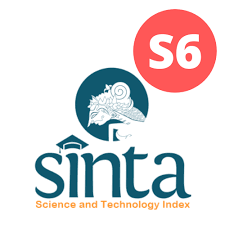Perancangan Silabus English for Young Learners Berbasis Kompetensi Teknologi Informasi dan Komunikasi
Abstract
This study aims to design a syllabus for the English for Young Learners (EYL) course that integrates Information and Communication Technology (ICT) according to the UNESCO ICT competency framework. Considering the importance of digital literacy in modern education, this research emphasizes that both teachers and students must master the latest technology to support the learning process. An analysis of EYL syllabuses from five universities in Indonesia shows that the current syllabuses do not fully meet the recommended ICT competency standards.The research method used is Design and Development Research (DDR), which aims to develop new products by analyzing existing products to suit current needs. Data were analyzed based on existing syllabus components and the required ICT competencies. The research findings indicate that several components, such as learning outcomes, teaching methods, and learning activities, are not well integrated. Therefore, this study designs a new syllabus that incorporates ICT competencies into each relevant component.The resulting ICT-based EYL syllabus is expected to create a more interactive and modern learning environment, enhancing 21st-century skills for students. Teachers are expected to act as facilitators who utilize ICT to provide a better learning experience. This designed syllabus is anticipated to become a comprehensive guide for education relevant to the digital era.
Penelitian ini bertujuan untuk merancang silabus mata kuliah English for Young Learners (EYL) yang terintegrasi dengan Teknologi Informasi dan Komunikasi (TIK) sesuai dengan kerangka kompetensi TIK UNESCO. Mengingat pentingnya literasi digital dalam pendidikan modern, penelitian ini menekankan bahwa baik guru maupun siswa harus menguasai teknologi terbaru untuk mendukung proses pembelajaran. Analisis terhadap silabus EYL dari lima perguruan tinggi di Indonesia menunjukkan bahwa silabus saat ini belum sepenuhnya memenuhi standar kompetensi TIK yang disarankan. Metode penelitian yang digunakan adalah Design and Development Research (DDR), yang bertujuan mengembangkan produk baru dengan menganalisis produk yang ada agar sesuai dengan kebutuhan saat ini. Data dianalisis berdasarkan komponen silabus yang ada dan kompetensi TIK yang diperlukan. Hasil penelitian menunjukkan bahwa beberapa komponen seperti capaian pembelajaran, metode pembelajaran, dan aktivitas pembelajaran belum terintegrasi dengan baik. Oleh karena itu, penelitian ini merancang silabus baru yang mengintegrasikan kompetensi TIK pada setiap komponen yang relevan.Hasil perancangan silabus EYL berbasis TIK diharapkan dapat menciptakan lingkungan pembelajaran yang lebih interaktif dan modern, serta meningkatkan keterampilan abad ke-21 bagi siswa. Guru diharapkan berperan sebagai fasilitator yang memanfaatkan TIK untuk memberikan pengalaman belajar yang lebih baik. Silabus yang dirancang ini diharapkan menjadi panduan komprehensif untuk pendidikan yang relevan dengan era digital.
Keywords
Full Text:
PDFReferences
Aris, J., & dkk. (2020). Panduan Penyusunan Kurikulum Pendidikan Tinggi di Era Industri 4.0 Untuk Mendukung Merdeka Belajar-Kampus Merdeka (Vol. IV). (S. S. Kusumawardani, Ed.) Direktorat Jenderal Pendidikan Tinggi Kementerian Pendidikan dan Kebudayaan.
Bilfaqih, Y. (2015). Panduan Menyusun Rencana Pembelajaran Semester (Rps)
Brown, H. D. (2001). Teaching bu Priciples: an Interactive Approach to Language Pedagogy. Second Edition. New York: Longman.
Dikti, T. (2016). Panduan Penyusunan Kurikulum Perguruan Tinggi. Retrieved from http://weekly.cnbnews.com/news/article.html?no=124000
Ishaq. (2015). Desain Pengembangan Pembelajaran Design Development Based Learning Information and Communication Technology ( Ict ). I(3), 73–85
Iskandar, I. (2017). RESEARCH DEVELOPMENT IN ENGLISH LANGUAGE TEACHING
Mateva, G., & Albena Vitanova, S. T. (2011). European Profiling GridUser Guide the European Profiling Grid (EPG).
Nevado-Peña, D. L.-R.-N. (2019). Improving quality of life perception with ICT use and technological capacity in Europe. Technological Forecasting and Social Change, 119734
Nurwahida. (2017). Developing English Materials for STAKPN Tarutung. Thesis, 16(November), 15–265. Retrieved from http://ijllalw.org/Past-Issues.html.
Richey, R., & Klein, j. (2007). Design and Development Research; Methods, Strategies, and Issues. Mahwah: Lawrence Erlbaum Associates.
Tsvetkova, M. (2016). The ICT Competency MOOCs for Teachers in Russia. Olympiads in Informatics, 79-92.
UNESCO. (2007). UNESCO ICT Competency Standards for Teachers (pp. 1–16). pp. 1–16. Retrieved from doi: 10.17485/ijst/2009/v2i3/29416
UNESCO. (2018). UNESCO ICT Competency Framework for Teachers. France: UNESCO.
Wahyuni, D. (2015). Konsep Dasar ICT - wahyuni.
Wolf, Z. R., Czekanski, K. E., & Dillon, P. M. (2013). Course Syllabuseses: Components and outcomes assessment. Journal of Nursing Education and Practice, 4(1), 100–107. https://doi.org/10.5430/jnep.v4n1p100
Yusuf, A. E. (2017). The Implementation of Ict Based Education in Elementary Teacher Education (PGSD) in Indonesia. Humaniora, 7(1), 8. https://doi.org/10.21512/humaniora.v7i1.3391
DOI: https://doi.org/10.17509/jpa.v7i2.69657
Refbacks
- There are currently no refbacks.
Copyright (c) 2024 JURNAL PAUD AGAPEDIA

This work is licensed under a Creative Commons Attribution-ShareAlike 4.0 International License.

This Journal is licensed under a Creative Commons Attribution-ShareAlike 4.0 International License.
©Jurnal PAUD Agapedia. ISSN: 2580-9679 (Online) dan 2581-2823 (Print).
Jalan Dadaha Nomor 18 Kota Tasikmalaya
Telepon (0265) 331860
Homepage: http://pgpaud-tasikmalaya.upi.edu/
Email: pgpaud_tasik@upi.edu






